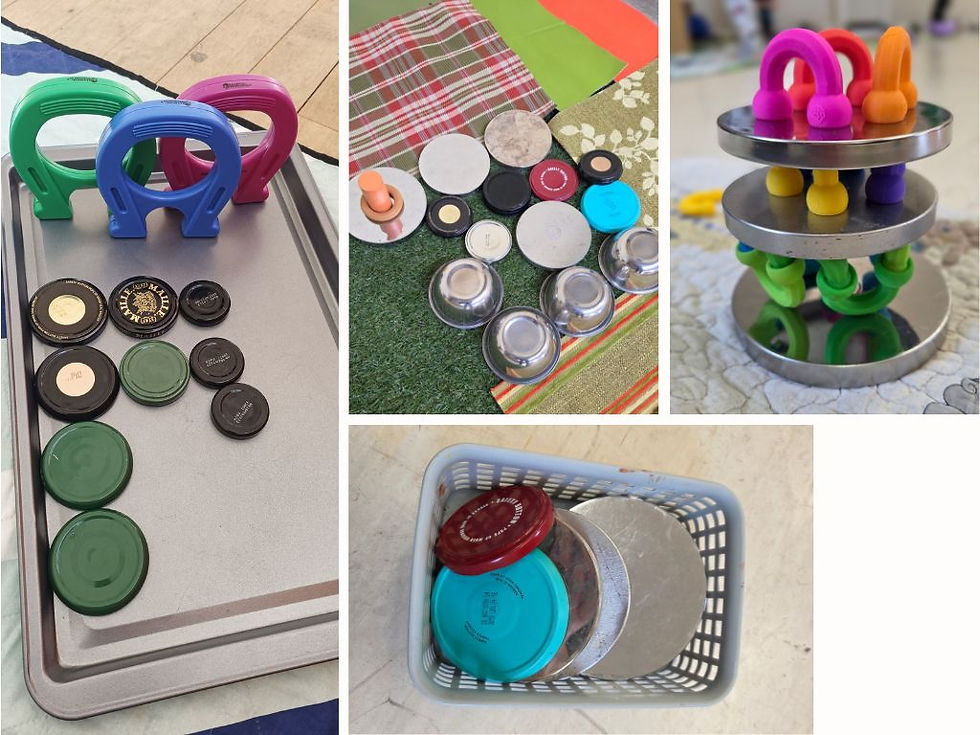Inspiration for “Invitations to Play”
- sha2201
- Aug 29
- 3 min read
What is an Invitation to Play?

An invitation to play is a simple and thoughtful setup of toys or resources designed to spark a baby’s, toddler’s, or child’s curiosity. It should be quick to prepare, taking no more than five minutes, and can be as simple as presenting a familiar toy in a new way.
For example, you might set the train tracks up on the table instead of the floor, or move them from the playroom into the sitting room and add a few dinosaurs to create a new scene.
For another invitation you might introduce opportunities to scoop and pour dried pasta with bowls and spoons if you have noticed that your child, or the children in your care, enjoy this repetitive action when playing with water.
These invitations give children the freedom to explore on their own terms while also showing them that you are paying close attention to their interests. They are particularly helpful during transitions. At home, this might be when a child wakes up in the morning, after a nap, or on returning from crèche or school. In an early years setting, it could be when children arrive, wake up from a nap, or come back in from outdoor play. You might even choose to set one up outdoors for them to discover. Transition times can often feel challenging for children, but having something interesting and engaging to focus on can help them regulate their emotions while creating a sense of welcome and connection.
Why Invitations to Play Matter
Invitations to play are grounded in what research tells us about child development.
A recent case study published in Language and Education (2024) described how a child settled into a new environment more smoothly when offered open play opportunities rather than being directed into structured activities. He became calmer and more confident because he was trusted to explore at his own pace. Research also highlights the emotional weight of being invited to play. For children who have experienced exclusion, a simple invitation can nurture belonging, empathy, and resilience (Taylor & Francis, 2020). Sensory play in particular has been shown to support both self regulation and cognitive development. When children explore through their senses, they are strengthening pathways in the brain that are linked to memory, problem solving, and emotional well-being. This is why it helps to include resources with a variety of textures, sounds, and visual interest when setting up an invitation to play. For example, think about offering something smooth alongside something rough, or materials that rattle and crunch as well as items that are soft and quiet. By providing this contrast, children are given richer opportunities to explore and learn, rather than everything feeling, sounding, and looking the same.
Inspiration for “Invitations to Play”
These invitations to play are based on my own previous setups and serve as examples of how everyday resources, or same toys (e.g., blocks) can be adapted to spark children's interest, introduce new ideas, or support their schematic play needs. Repetition is important for building children's confidence and skills, but we can still introduce new and exciting ways to explore the same concepts—for example, building fine motor skills in different ways and with different materials.
Feel free to use these photos as inspiration, swapping out resources for ones you already have or can easily source. Set them up for babies, toddlers, or children to explore freely. It is okay if they engage with them differently than you imagined, as long as it is safe for them to do so. It is also okay if they choose not to engage at all; simply leave the setup available and observe what happens over time. Some children may need you to model how to interact with the materials before they take the lead.
Many of these setups may not look perfect or Instagram-worthy, but what truly matters is that they reflect children's emerging interests, support their stage of development, and encourage engagement. The focus should always be on meaningful play rather than a picture-perfect setup!
Enjoy! :)












Comments